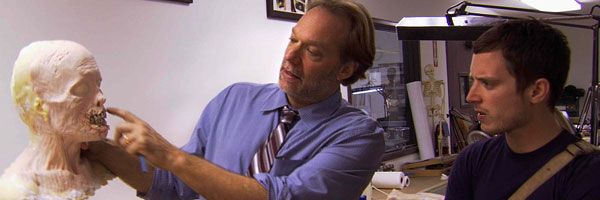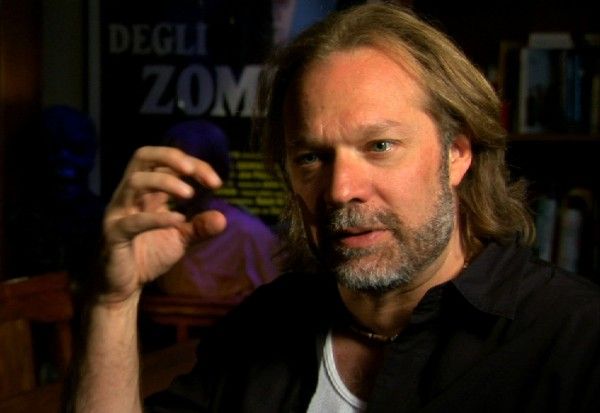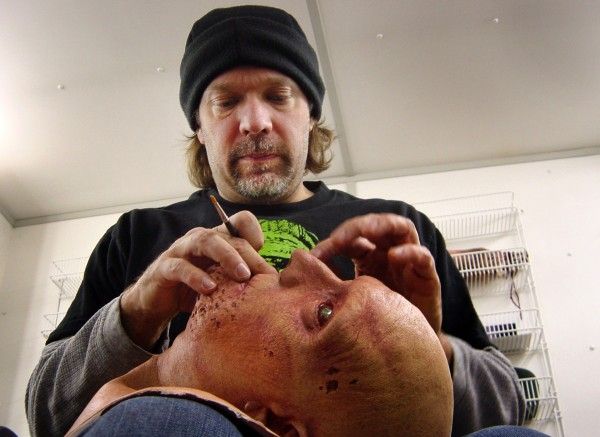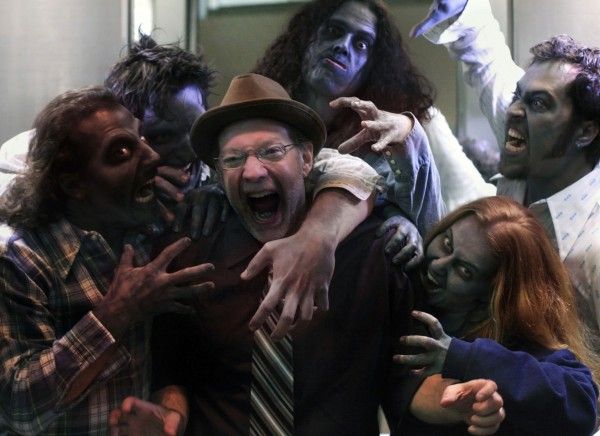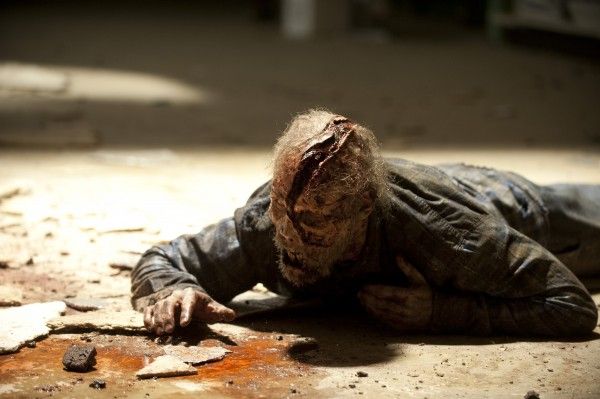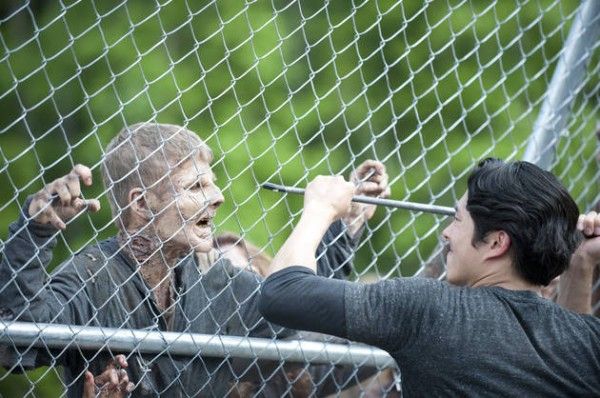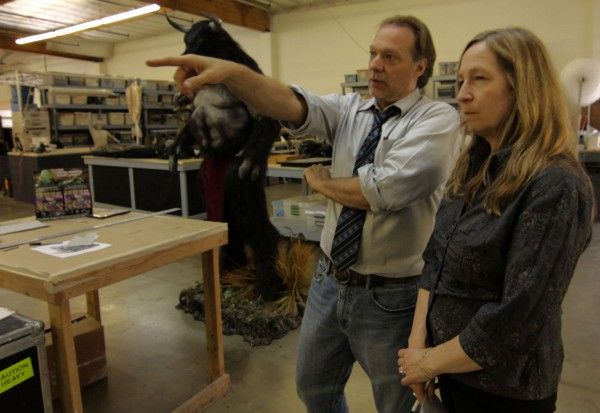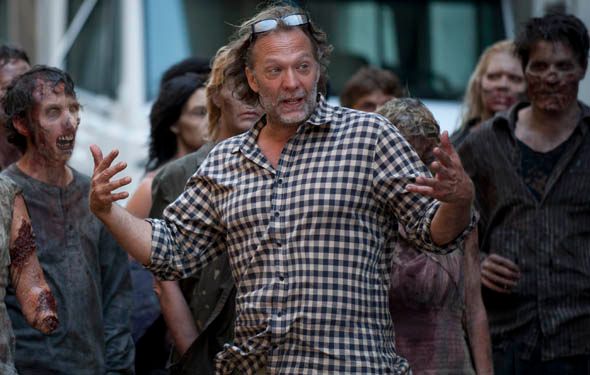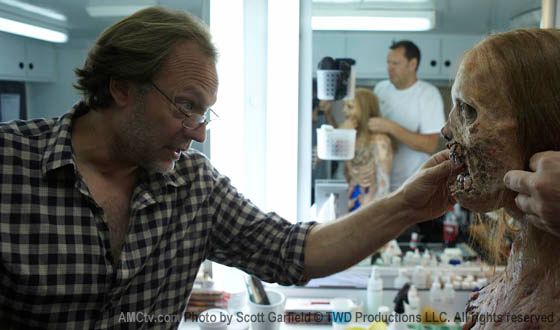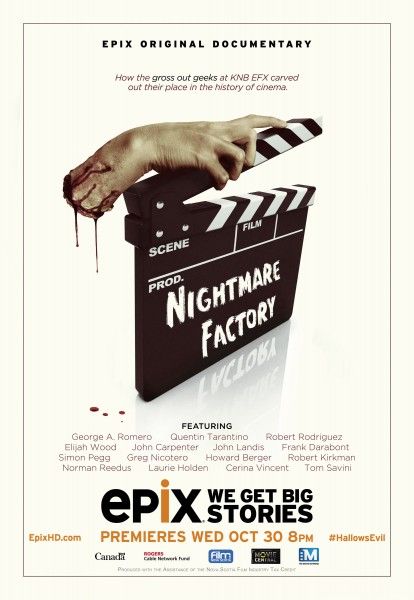Directed by Donna Davies, the EPIX original documentary Nightmare Factory, premiering quite fittingly on October 30th, is about the acclaimed Oscar-winning Hollywood special effects house KNB, which is responsible for creating The Walking Dead zombies and the make-up effects for close to 1,000 feature films. More specifically, the story follows how Greg Nicotero’s boyhood fascination with monsters drove him to have a hand in creating (along with Howard Berger and Robert Kurtzman) one of the most prolific make-up effects studios in the world. The film features George A. Romero, John Carpenter, John Landis, Tom Savini, Frank Darabont, Quentin Tarantino, Robert Rodriguez, The Walking Dead’s Norman Reedus and Laurie Holden, and Elijah Wood, along with some incredibly cool behind-the-scenes footage.
During this recent exclusive interview with Collider, Greg Nicotero talked about how his career happened completely by chance, letting his parents know that he was leaving med-school to get into the movie business, what it’s been like to see how popular zombies have become, thanks in large part to the success of The Walking Dead, the challenges of working on a TV show for an extended period of time and always having to come up with new things, what makes this season of The Walking Dead its best, doing Mickey Rourke’s Marv make-up again for Sin City 2, and spending his upcoming hiatus working on vampires for Robert Rodriguez’s From Dusk ‘Til Dawn TV show. Check out what he had to say after the jump.
Collider: How did you end up having so much behind-the-scenes footage of the projects you worked on, throughout your career? Did you just always have a video camera with you?
GREG NICOTERO: Fortunately, I had a video camera with me, at all times. I was interested in that when I was much younger, when video cameras were scarce and hadn’t really hit the market. And then, when I did Day of the Dead with Tom [Savini], he was video-taping everything, so I became the documentarian of all that stuff. I have hours and hours and hours and hours of behind-the-scenes footage of all of those movies. It was fun for me to have people get an opportunity to see that stuff that we shot.
Because you had so much footage, were you looking to get involved with a documentary?
NICOTERO: No, I was approached. Donna Davies, who produced the documentary, had done a previous doc called Zombie Mania and interviewed myself, George Romero and Tom Savini. I gave her access to some of my behind-the-scenes footage from the set of Land of the Dead, and she said, “Wow, this footage is unbelievable! Have you ever thought about doing anything with it?” I said, “Well, we have so much – everything from Evil Dead 2, all the way to Inglourious Basterds to Predators.” I was constantly video-taping stuff on set, more as just a personal record than anything else. So, she said, “What do you think, if we could put something together and showcase your story as a young kid, growing up in Pittsburgh and looking at filmmaking as a hobby, and following your dreams?” It was really exciting for me to be able to give fans a look at some of that footage that no one has ever seen before.
What was it like to work with Tom Savini?
NICOTERO: When I started with Savini, Tom was the rock ‘n’ roll make-up effects guy. He was probably the first guy who really became a household name because of make-up effects. Because of Dawn of the Dead and Friday the 13th, Tom became a household name. Between him, Rick Baker, Dick Smith and Rob Bottin, in the late ‘70s, when make-up effects were really coming into the forefront, they were the stars of the movies. That’s what happened. When you watched Friday the 13th, you really didn’t remember anybody that was in the movie. You just remembered the great kills. It ushered in the era of the splatter movies, and all of that great stuff that went from 1977 to 1990.
There was that 13-year era where everybody wanted to do make-up effects, and people were interested and excited about every one of those movies that came out. I remember seeing The Thing, An American Werewolf in London, The Howling and The Fog. I ran to the theater to see all those movies, just as much for Rick Baker and Rob Bottin than anything else. It was a great time. I moved to L.A. in ‘85, after working on Day of the Dead, and it was right at the pinnacle of make-up effects. The fun thing about the documentary is that it shows we were all 21, 22 and 23-year-old kids who were following our rock ‘n’ roll dream of doing make-up effects and blood. We all had long hair and we all listened to Metallica. It was our rite of passage.
Did you have a moment when having a love for monsters, zombies and effects was something you decided to turn into a career?
NICOTERO: My career was all completely by chance. I had known George Romero for years. I had gotten to be friends with him and his wife, at the time. They had offered me a job on Creepshow in 1981, as a P.A. They were like, “We’re getting ready to do Creepshow. What do you think?” I was 17 years old and I was getting ready to go away to college, and I said, “I’d love to, but I’m getting ready to go away to school to study pre-med. I just don’t think it’s going to work out.” So, I’d had that opportunity arise in ‘81.
When Day of the Dead came about in July of 1984, it was the same thing. They said, “Hey, man, we’re doing Day of the Dead. What do you think?” In my head, I thought, “Okay, I passed up this opportunity once. I can’t do that twice.” In the time between 1981 and 1984, I had become much more interested in film and much more of a student of creature effects and make-up effects. I always looked at it as a hobby. It was always a great opportunity to follow my dream, but I never said, “Oh, this is what I want to do for a living!” It just happened, and I followed those paths that were laid out in front of me. The next thing I knew, I was there.
Do you remember what the conversation was like, when you had to break it to your family that you were leaving a pre-med major to turn people into zombies?
NICOTERO: I do! I remember it exactly. My parents were upstairs in their bedroom. I remember walking upstairs and saying, “Hey, guys, I just wanted to talk to you because I got offered a job on Day of the Dead, as Tom Savini’s assistant, and I want to take a semester off of school. I’m going to go back in January, finish up my school and be a doctor, but I just want to take a semester off and work on this movie.” They just looked at me and were like, “Okay!” That was a very, very important moment for me because they didn’t say, “No, you’ve gotta go back to school and get your diploma.” They literally were like, “You know, Greg’s got a good head on his shoulders, so sure.” It wasn’t an issue. They really never made any beans about it. I think that they figured that whatever would happen, would happen. Coming from a point where I was poised to take over my dad’s medical practice to working on a George Romero zombie movie was a bit of a different path than they had anticipated.
As someone who really has been in the zombie business for some time now, what’s it like to see how The Walking Dead has made them so popular, on a scale that they never have been before?
NICOTERO: For me, it’s tremendously rewarding. I remember when 28 Days Later came out, and I loved it. I thought it was great. I was really, really excited about the fact that people were re-energizing the zombie movie. I didn’t love the remake of Dawn of the Dead, and I get a lot of grief from people about that. I’m such a hardcore fan of the original that it was sacrilege to me that they even made it. I get into arguments about it. Quentin Tarantino and I argue about that movie, all the time. He’s like, “Come on, man, the opening 15 minutes is great!” I’m like, “I’m not saying it’s not great, but if it would have been called anything other than Dawn of the Dead, I probably would have reacted very differently to it.”
But because of that, I met Simon Pegg and Edgar Wright and became a huge fan of Shaun of the Dead. For me, 28 Days Later and Shaun of the Dead really re-invigorated the zombie genre. Something that people don’t think about are all the zombie shot ‘em up games, like The House of the Dead and Resident Evil. I think video games did quite a bit for the resurrection of the zombie mythology. When you put a toy plastic gun in someone’s hand, and they can point it at zombies and shoot them, I think that did a lot for the genre. It made zombie movies and zombie material interesting to kids who were 14, 15 and 16 years old because they were playing all of those games.
At the Season 4 premiere of The Walking Dead, Gale Anne Hurd talked about how it gets harder and harder, every season, to part with cast members, even if it’s good for the story. Do you approach that from a different place, in that if a character gets killed off, then you can turn them into a really grotesque and awesome zombie?
NICOTERO: No. We really only did that with Merle (Michael Rooker). Merle was a character that we killed who came back. I would probably side with Gale, in that regard. It’s harder because these are characters that we’ve created and it’s not like a movie where, eight, ten or twelve weeks later, you’re done and everybody goes off their own way. We’re into it for four years and there are these relationships that we have with these actors, as well as the characters. I still miss Jon Bernthal and I still miss Jeff DeMunn, and they were gone two seasons ago.
Are there challenges that are specific to doing a project like The Walking Dead, where you’re on it for an extended period of time and always having to come up with new things, as opposed to film where it’s a finite amount of work?
NICOTERO: Well, it constantly evolves. One of the best things, for me, about The Walking Dead is that I have a lot of creative freedom to design all the gags and all the walkers. Some of that stuff is not written into the script. Some of it is just things that I want to do, or things I know haven’t been done before. So, it’s challenging because we have eight days of prep per episode, and then eight days to shoot. It’s challenging, in terms of the volume we have to turn over. It’s not like a movie where I have 35 make-up artists and three months to prep or build something. It’s a completely different animal. But because of the pedigree of KNB and how our company has evolved over the last 25 years, we’re able to handle a project like this, just in terms of how I visualize things and how my crew executes those visions. It really is a completely different experience than working on movies. For me, it’s different because I’m also the executive producer, so I build what I want to see and I shoot what I want. Very rarely does anybody ever say, “Oh, can you show us a test of what that’s gonna look like?” They just figure, “Well, Nicotero knows better than anybody else, so we’ll just let him run with it.” For a make-up effects person, it’s probably the best opportunity that you could have because you really have the creative freedom to do whatever you want.
Many people have been saying that this season is the best season of The Walking Dead. What would you say makes that true?
NICOTERO: I believe that we really hit our stride this year. Scott Gimple, who is our showrunner, understands this show better than anybody else. He was a fan of the show before he even got hired onto it. He, along with myself, Gale, Robert Kirkman, Andy Lincoln and the actors are just dedicated to telling great stories. This season, there’s a lot of intrigue and there’s mystery. Where did this virus come from? Who burned up the two bodies in the prison? I just feel like we’ve done more character development in the first two episodes than we did in half of last year.
The documentary shows that you always want to be in the trenches of whatever it is that you’re working on, but how difficult is it to do that with the show being so demanding? Are you still able to juggle multiple projects, or has that become much more challenging?
NICOTERO: It’s more challenging for me now because I have five jobs to juggle on The Walking Dead. I’m in Georgia for six months out of the year. Fortunately for me, during our hiatus, I’ve been lucky enough to work on Django Unchained, and last year I did Sin City 2. I haven’t really been in a situation where I’ve had to say no to a great friend of mine, like Frank Darabont or Quentin [Tarantino] or Robert Rodriguez. So far, so good. Pretty soon, there will come a time when I’ll be like, “Oh, shit, I really want to go work on that project, but I can’t ‘cause I’m on The Walking Dead.” But, that’s just the way life is. It’s pretty amazing. It’s exciting for me, when people want to just come up to you on the street and tell you how much they love something you’ve done. For me, The Walking Dead is such a big part of who I am, with my contributions to the show, that it’s the ultimate compliment to me. I love having people come up to me and say, “I know what’s gonna happen next week!” I’m like, “Okay, tell me.”
Now that it’s been announced that there’s going to be a companion series, how much more complicated will that make things for you?
NICOTERO: It’s never easy. When it rains, it pours. As far as I’m concerned, I’m just happy that we have a show out there that 20 million people watch. I would have never imagined, in a million years, that we would have a show that literally was the number one most-watched show on cable television. It’s astounding to me. We get together and watch the show together, every weekend. We’re so proud to be able to give the fans something like this, and so dedicated to doing it. Andy Lincoln and I spent so much time talking about what we wanted for the show and what direction we felt The Walking Dead should go in. Fortunately, our vision was shared by Scott Gimple and Gale Anne Hurd, and we were able to keep the show pure. That, to me, is the most rewarding. We really wanted to make sure that the show was everything that it could be for the fans.
What was it like to be able to return to Sin City for the sequel? Could you ever have imagined that you’d be doing Sin City 2, so long after the first film?
NICOTERO: It was nine years. It was great! We got to do Mickey Rourke’s Marv make-up again. Bruce Willis was there. Doing the first Sin City was a really fun experience. We spent four months shooting on green screen. Robert really was not only one of the first guys to do a 3D movie in recent years, when he did Spy Kids 3D, but he created that green screen world for Sin City. Robert is a maverick filmmaker. It was exciting for us to be able to go back and get a second chance to do that kind of movie again. It was so much fun! We had a great time. It was cool to see new cast members come in, and it was fun to have people like Mickey, who we loved working with and loved doing his make-up. It was great! It was really a blast. I’m dying to see the movie. Robert keeps offering to show it to me, but I don’t want to see it with the green screen. I don’t want to see it until it’s finished. I want to go in and experience it as the rest of the world will experience it.
How often do you try to work yourself into the projects you do, whether it’s as a monster, a creature, a zombie, or whatever?
NICOTERO: I have fun doing it. I’ve been a zombie. I hold the record for the most appearances in Romero zombie movies ‘cause I was in Day of the Dead, Land of the Dead and Diary of the Dead. I was in three zombie movies, as different zombies. I don’t think anyone else has done that. On The Walking Dead, I like being a zombie. It’s fun. I like going through make-up. We did a couple of bruises on Andy Lincoln one day, and he said, “God, it’s so great! It transforms you into a different person.” When you look at actors and performers who love to wear make-up, like Eddie Murphy who loves to create these characters, it really does allow them the freedom to be a different person. I explain to my kids, “It’s like Halloween. You put on a mask and you’re a different person.” Going into make-up and getting a chance to do little cameos in things, here and there, is just fun ‘cause you get to be a different person.
Do you consider somebody saying, “How did they do that?!,” to be the ultimate compliment for the work that you do?
NICOTERO: Absolutely! That’s what I strive to do. I remember sitting in the theater and watching movies and going, “Holy shit! How did they do that?!” I did that when I watched The Thing. I did that when I watched Little Shop of Horrors, as a crazy example. Watching the big plant singing, I was like, “How did they do that? That’s ridiculous! I love that!” So, when people try to speculate about how we did something, to me, that’s how I entertain these effects. I want people to ask, “How did they do that?!” In this day and age, it’s easy because people go, “Oh, they just used CGI for that.” But, it’s those moments where they go, “Is that a puppet? Is that make-up? How did they do it?” That’s the number one question. That’s the spark. When I saw Jaws and I saw a giant 25-foot shark eating Robert Shaw, I was 13 years old going, “How the fuck did they do that?!”
Is the magic gone for you, when you watch stuff now, because you know what goes into it and how it’s done?
NICOTERO: Yes, and I hate that! There’s always some featurette that shows you how it’s all done. If there had been a featurette saying, “See how Linda Blair was turned into a demonic child in The Exorcist,” it would have taken away the mystery and what’s exciting about it. Sometimes I would rather not know. I don’t want to know how they did it. I just want to be transported and taken to another planet in a fantasy world. When a movie succeeds, it takes me to another world where I don’t think about it and I’m just immersed.
How many times have you created a gag or an effect that just didn’t work, once the cameras were rolling?
NICOTERO: There’s been a few misses. The beauty of film is that you get to do it again. You get take two and you get take three. What I’ve always strived to do is fine tune and refine everything that I do. So, being able to do zombies four years in a row on The Walking Dead, I feel like the make-up gets better and better because we’re able to refine and see what works and what doesn’t work, and then take that to the next level. As a movie fan, my number one goal is to continue to learn from what I’ve done and make these effects as precise and clean as they can be.
Have you had clashes with directors who want to cut corners on a gag or effect because they don’t understand what goes in to making it work?
NICOTERO: I don’t know if it’s that they don’t understand what it takes, but it’s always a challenge. There are times when budget factors into it. You’ll work with a director who will be like, “Listen, I want this really great fake head, but I’ve got $1.98.” They don’t really understand the artistry of sculptors and painters and mold makers. It takes a couple weeks to build something, and then you want to test it. Once you test it, you want to refine it again. That happens quite a bit. Some people understand it and some people don’t. Some people don’t understand that it’s a process. You can’t just call somebody and go, “Hey, I need a fake head,” and then you pull it out of a box.
When you think back about everything you’ve accomplished, from where you began, what most surprises you about your journey?
NICOTERO: What surprises me the most is that I made really smart decisions. I had a lot of crossroads in my career where I could have done one film or another. A perfect example is when I had the opportunity to work on The Texas Chainsaw Massacre 2, but that happened at the exact same time as Evil Dead 2, and I chose Evil Dead 2. Ultimately, that was the project that really was the genesis of KNB. Howard [Berger], Bob [Kurtzman] and I had all worked together on Evil Dead 2, and we realized that the three of us complimented each other perfectly and we started out own company.
There were a lot of instances in my career where I had the choice to go left or the choice to go right, and I always made the right choice. That benefitted me, every single time, because I would look back and go, “Wow, if I would have done that movie, my career would have gone a completely different direction.” I really had the right nose for making the right decisions, in terms of which projects to do and which projects to stay away from. The people that I ended up becoming very close to in my career, like Quentin Tarantino, Robert Rodriguez and Frank Darabont, are the guys who inspire me.
Do you already know what you’re going to work on, during the next hiatus for The Walking Dead?
NICOTERO: Yeah, I’m gonna go work on the From Dusk ‘Til Dawn TV series that Robert is doing. I’m going to direct an episode or two, and do some cool vampires. I’m excited about the fact that we wrap The Walking Dead in the middle of November, and then I get a chance to go and work with my buddies on that show. And then, I get to go back and do more zombies, for the next five years.
What network will that show be on?
NICOTERO: It’s his own network. Robert has his own network, called El Rey. I think From Dusk ‘Til Dawn is his first foray into that.
Nightmare Factory airs on EPIX on October 30th.

